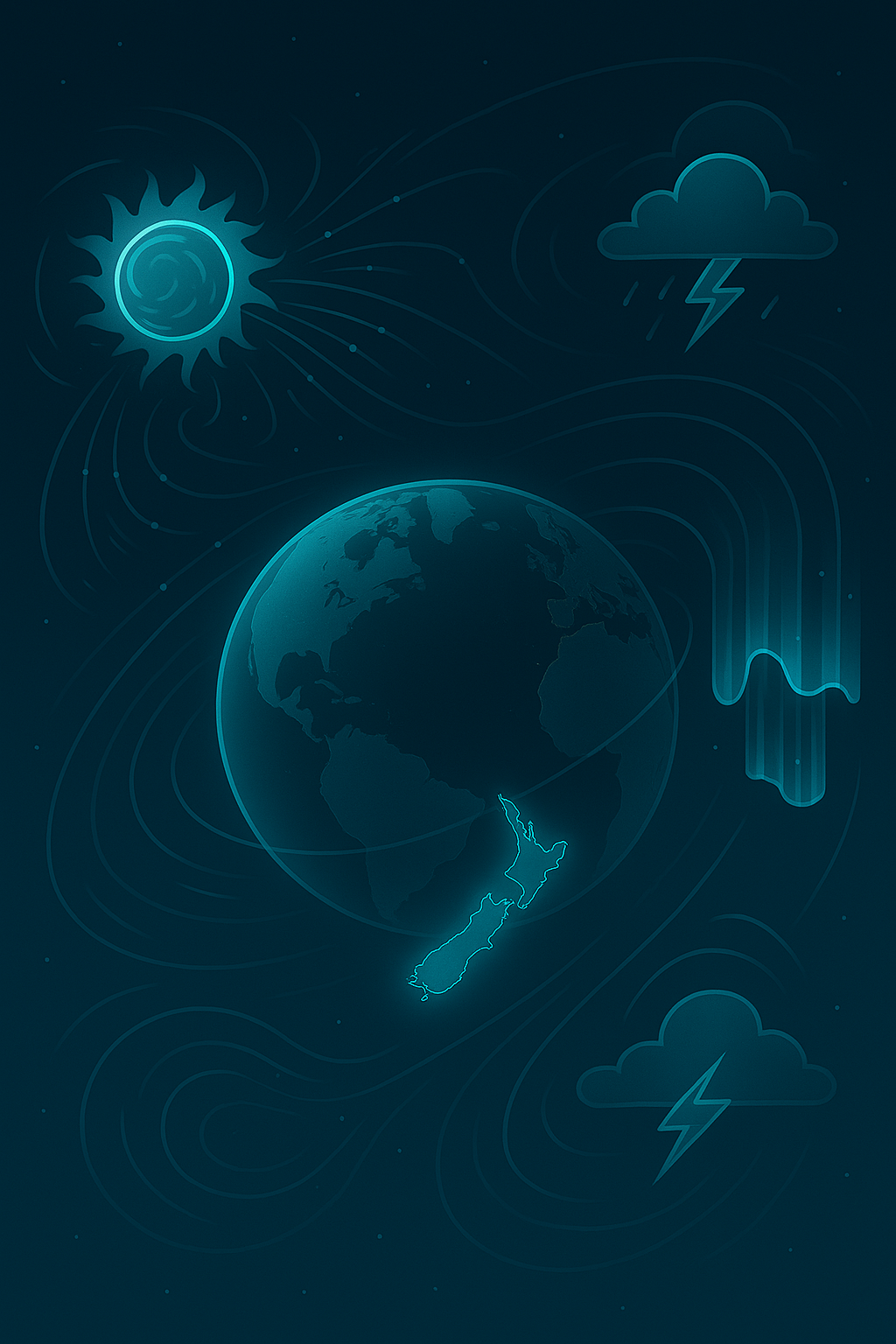Case Study: Vulnerability of the Pacific Islands to Space Weather
Space weather—disruptions in the space environment caused by solar activity—poses serious challenges to modern societies. For the Pacific Islands, a region heavily dependent on satellite communications, navigation, and power supplies, the effects of space weather can be particularly severe. This article examines the unique vulnerabilities of the Pacific Islands to space weather, highlighting the possible consequences, mitigation approaches, and the vital importance of preparedness in this remote yet interconnected region.
Understanding Space Weather
Space weather stems from solar phenomena, including solar flares, coronal mass ejections (CMEs), and high-energy solar wind. These events release vast amounts of energy, impacting Earth's magnetosphere, ionosphere, and technological systems. Main aspects of space weather include:
1. Geomagnetic Storms: Disturbances in Earth's magnetic field caused by CMEs and solar wind, affecting satellites, power grids, and navigation systems.
2. Solar Radiation Storms: High-energy particles from the Sun that can disrupt satellite electronics and pose dangers to astronauts.
3. Radio Blackouts: Interruptions in high-frequency (HF) radio signals caused by solar flares, affecting aviation and maritime communication.
The Path Forward: Building Resilience
The Pacific Islands must focus on building resilience to space weather as part of their wider disaster preparedness plans. Investing in monitoring systems, satellite technology, and regional cooperation is crucial for protecting vital infrastructure and maintaining economic stability.
Emerging Technologies
Advances in small satellite tech and space weather forecasting tools offer promising options for the Pacific Islands. Affordable CubeSats can deliver localised monitoring, while AI-powered models enhance the accuracy of space weather predictions.
Global Efforts to Address Space Weather
The United Nations Office for Outer Space Affairs (UNOOSA) and the World Meteorological Organization (WMO) are developing international frameworks to reduce space weather risks. Pacific Island nations can benefit from these initiatives through active engagement and collaboration.
Unique Vulnerabilities of the Pacific Islands
The Pacific Islands are especially vulnerable to space weather because of their geographic isolation, dependence on satellite technology, and limited land-based infrastructure.
1. Dependence on Satellite Communications
Connectivity: The Pacific Islands rely heavily on satellite systems for internet, phone, and broadcast services due to the lack of extensive undersea cable networks. Geomagnetic storms can disrupt these systems, leading to widespread communication outages.
Emergency Services: Satellite communication is crucial for disaster response and coordination in this cyclone-prone region. Disruptions caused by space weather could delay rescue efforts and worsen humanitarian crises.
2. Navigation and Transportation
Maritime Navigation: The vast ocean territory of the Pacific depends on Global Navigation Satellite Systems (GNSS) for safe shipping and fishing activities. Space weather can impair GNSS accuracy, resulting in navigation errors.
Aviation: Airlines operating in the Pacific region rely on satellite-based navigation and communication. Space weather events can interfere with these systems, causing flight reroutes and increasing safety risks.
3. Power Grid Challenges
Although the Pacific Islands have smaller power grids than larger countries, geomagnetic storms can still induce ground currents that damage transformers and disrupt power supplies. Island nations with ageing or limited electrical infrastructure are particularly at risk.
4. Impact on Climate Monitoring
Satellites are vital for tracking climate change and weather patterns across the Pacific, including cyclones, sea-level rise, and coral reef health. Space weather can impair satellite sensors and delay the collection of essential environmental data, reducing the accuracy of forecasts and climate prediction models
Consequences of Space Weather Events for the Pacific Islands
The impacts of space weather on the Pacific Islands are extensive:
Economic Disruptions: Prolonged satellite outages can cripple e-commerce, banking, and tourism, which are vital to Pacific Island economies.
Safety Risks: Navigation errors in maritime and aviation sectors increase the risk of accidents, threatening lives and property.
Hindered Disaster Response: Without reliable communication and navigation, disaster relief efforts may be delayed, worsening the effects of natural calamities.
Scientific Setbacks: Interruptions in satellite data collection impede environmental research and climate resilience planning
Case Studies: Space Weather Impacts on the Pacific
1. GNSS Disruptions During the 2003 Halloween Storms
The 2003 solar storm caused significant GNSS signal degradation, affecting maritime and aviation sectors worldwide. In the Pacific, this event highlighted the region's dependence on satellite navigation and the necessity for backup solutions.
2. Communication Outages in the 2012 Solar Maximum
During the solar maximum of 2012, HF radio blackouts disrupted emergency communications in remote Pacific communities. This event emphasised the vital role of satellite systems in disaster response.
3. Cyclone Winston Recovery Challenges, 2016
Following Cyclone Winston, satellite systems were crucial in directing relief efforts. A simultaneous space weather event could have seriously delayed these operations, worsening the humanitarian situation crisis
Mitigation Strategies for Space Weather Vulnerabilities
Addressing the Pacific Islands' vulnerability to space weather requires a multi-faceted approach that combines technology, policy, and international cooperation.
1. Improved Space Weather Monitoring
Regional Monitoring Centres: Establishing regional centres equipped with real-time space weather monitoring facilities can enhance early warning systems.
Collaboration with Global Agencies: Partnering with entities like NASA, NOAA, and the European Space Agency (ESA) ensures access to advanced space weather forecasts.
Investment in Local Expertise: Training local scientists and technicians in space weather analysis empowers Pacific Island nations to interpret data and respond effectively.
2. Robust Satellite Infrastructure
Hardened Satellites: Promoting the use of satellites built to withstand radiation and electromagnetic interference reduces damage risks during space weather events.
Backup Systems: Diversifying communication and navigation options with terrestrial and underwater alternatives can lessen reliance on vulnerable satellite networks.
3. Public Awareness and Preparedness
Education Campaigns: Raising awareness about space weather among policymakers, industry, and the community encourages better preparedness and response.
Emergency Protocols: Developing contingency plans for communication and navigation outages helps maintain services during disruptions.
4. International Collaboration
Data Sharing: Open data-sharing agreements between nations and organizations enhance regional preparedness.
Joint Research Initiatives: Collaborative studies on space weather impacts specific to the Pacific Islands improve understanding and mitigation strategies.
Conclusion
Space weather is a significant yet often overlooked threat to the Pacific Islands, with the potential to disrupt communication, navigation, and disaster response systems vital to the region's commerce and safety. While challenges remain, proactive measures—such as enhanced monitoring and international collaboration—can reduce these risks and strengthen resilience. By adopting technological innovations, encouraging regional cooperation, and investing in education, the Pacific Islands can safeguard their economies and communities from the unpredictable impacts of space weather, ensuring a sustainable and secure future.


